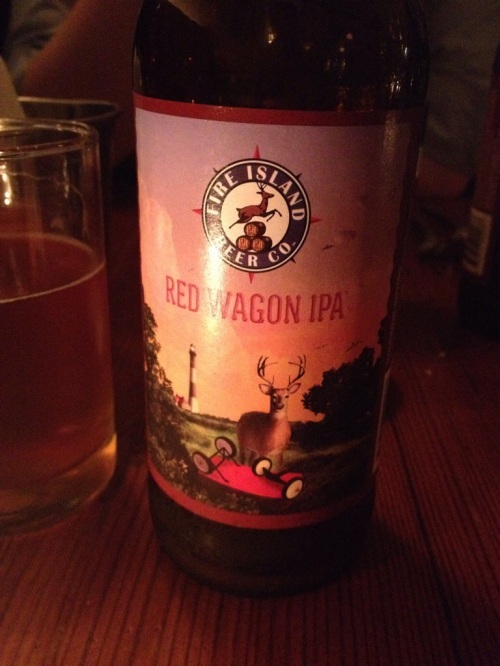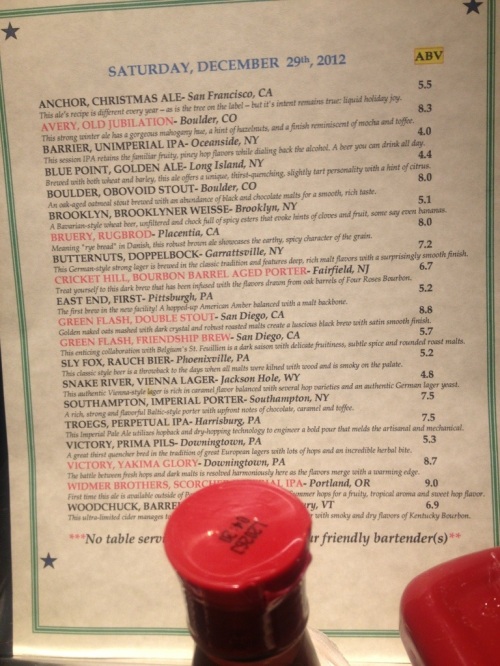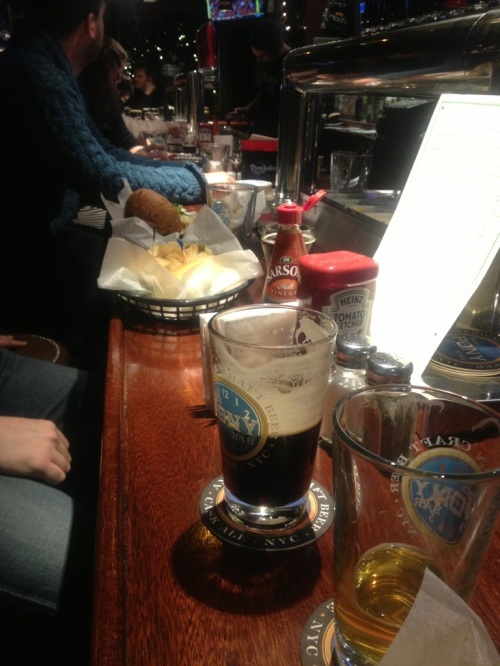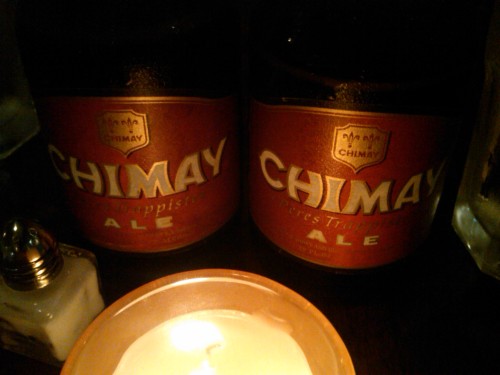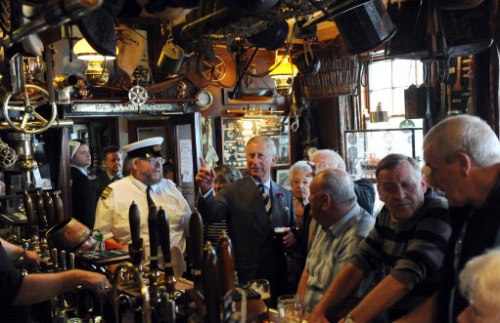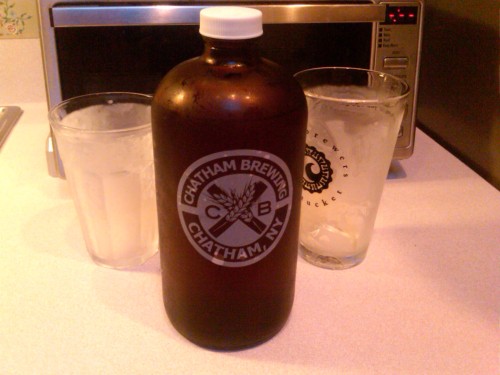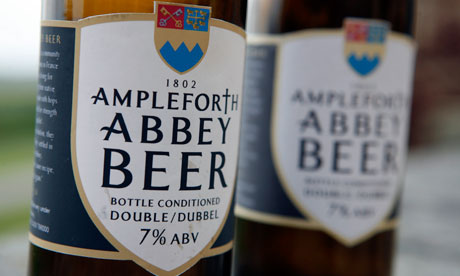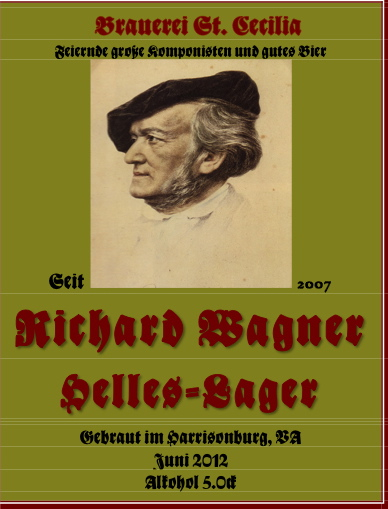Evening IPA
Filed under Uncategorized
Free beers!
Filed under Uncategorized
Royal favour
The Prince of Wales enjoys a pint at the Olde Ship Inn, Seahouses, Northumberland.
Filed under Beer in the News
Chatham Pale Ale
Filed under Uncategorized
Beer in the News: Monastic Brews
As our Lager sits in the Lagering Refrigerator, here is a delightful short video post from the BBC.
Yorkshire Monks Return to Brewing
And here we offer a story reprinted from The Guardian.
Ampleforth monks mix history, religion and malts in unique new beer
Benedictine community in Yorkshire to sell Britain’s first monastic beer since the Reformation
The monks pace serenely in their long black habits, to a background of chanted psalms and obedient students from Ampleforth College swotting for exams.
But beneath the peaceful surface of Ampleforth Abbey, in a lovely North Yorkshire valley, lies a commercial operation that is about to pull off a coup – Britain’s first monastic beer since the Reformation, more than 450 years ago.
Tawny glasses of Ampleforth Abbey brew have circulated among testers for the past year and, following repeated tweaks of yeast and malt, the beer is to go to the market in July. The launch is eagerly awaited in drinking circles because of a heady mix of history, religion and the Benedictine order’s formidable reputation in the field.
“We think we’ve got the taste and texture right,” said Father Wulstan Peterburs, Ampleforth’s procurator, whose job is to oversee St Benedict’s rule that monks should be self-sufficient and busy in their worldly as well as spiritual lives. “The last time the order did this in a big way, in the 18th century, we were given a licence by Louis XIV to sell our beer everywhere in France. We’re not being that ambitious but we think we’ve got a success on our hands.”
The beer is strongly flavoured and limited to 330ml bottles because of its gutsy 7% alcohol by volume. It is being brewed after a decade of cider production by the monks, which has gone from a homemade press in a derelict farm to 22,500 litres a year, and was honoured, again, at last month’s International Cider Challenge.
The drink joined beekeeping and production of Father Hugh’s vanilla and fudge cheesecake as a pursuit after enthusiasts in the 70-strong brotherhood consulted the Rule of St Benedict, a book of precepts written about 1,500 years ago concerning what to do with surplus apples from the two-hectare (five-acre) orchard.
“The answer was pretty obvious,” said Peterburs, “and our decision to revive beer making happened in a similar way. We are always looking for things for monks to do, especially as some of the community are on the older side, and this was ideal. It also draws interestingly on our history.” said Peterburs.
Harried during Europe’s political and religious convulsions, the Benedictines took their classically English brewing skills to France after Henry VIII’s Reformation, then returned with a distinctly European type of beer when the French revolution made them homeless again in 1789. The process, unused since, apart from a brief 19th-century experiment outside the monastery, has given the brew an invaluable marketing tool: ancient documents referring to secret recipes.
“Les matières qui la composent sont des grains, blés barbus et orges, des houblons et de l’eau,” says one relic from the exile in France, listing wheat, hops and other ingredients that made up what the writer called “le grand secret de fabrication des Benedictines Anglais”.
In the abbey’s thriving shop , the custodian, Father Jeremy Sierley, said the beer would fit nicely with the monks’ other lines, from peach brandy to asses’ milk soap, as well as with St Benedict’s rules on retailing.
“Just like the interest in sustainability which all sensible people have these days, we are guided to avoid avarice and practice fair dealing,” he said. “The Rule talks about asking ‘lower prices than the rest of the world so that God will be glorified’.”
The principle of rejecting excess profit, which also contributed to the success of Yorkshire Quaker businesses such as Rowntree’s in nearby York, is enshrined on every Ampleforth till receipt, which ends “ut in omnibus glorificetur Deus”.
Prices should be high enough to keep the brew away from the binge-drinking market or misuse by young people. Peterburs said: “We have given thought to this, and we teach our students here about responsible drinking.”
Staff at the college, who include a qualified sommelier, have helped test the beer, with tips including advice to marginally increase the frothy head, which is ever-popular on beer in northern England.
The drink is making its debut in a part of the UK with strong ties to the partnership of alcohol and religion. Just up the valley at Lastingham, an 18th-century vicar made ends meet by running the local pub through his wife, playing the fiddle in the bar and defeating a legal challenge by arguing that this was true service to his parishioners.
Across the Pennines, in Burnley, the Miners and Working Men’s social club is the world’s biggest single outlet for Benedictine liqueur, sold with boiling water as “Benny & Hot“, a mixture that kept the Lancashire fusiliers going in the trenches in France during the first world war.
A brewhouse alongside Ampleforth’s cider press is the long-term aim but initially the beer is being produced at Little Valley brewery in the upper Calder Valley, West Yorkshire. Double-fermented and overseen by Little Valley’s Dutch co-founder, Wim van der Spek, a specialist in the monkish tradition of Trappist beers, it will sell at £36 for a 12-bottle case.
Filed under Uncategorized
The Summer of Brews, Part II: Helles Lager
Richard Wagner was an asshole. There’s no other way to say it, really.
In addition to being vain, conceited, histrionic, self-serving, and an all-round Machiavellian, he was also a rampant anti-Semite. His polemic 1850 essay Das Judenthum in der Musik (Jewishness in Music) is an atrocity and without a doubt one of the great embarrassments of modern Western culture. The adoption of his music by the National Socialists 50 years after his death sealed his fate as a problematic figure for posterity.
But the fact remains that he was a musical genius: without a doubt, he nearly single-handedly changed the course of western art music in general, and opera in particular. To ignore Wagner because of his politics would be (somewhat) akin to ignoring Pablo Picasso because he was a womanizer, or Leonard Bernstein because he was a pædophile. Wagner’s chromatic harmonic language, orchestral writing, and sense of the dramatic paved the way for both the post-tonal revolution of the early 20th century and the neo-Romantic style of the late 20th century. He invented a new brass instrument. He designed his own theatre and wrote his own opera librettos.
sequential unresolved diminished 7th chords…as delicious as a Munich lager…
Thus, even as we lament Wagner’s misguided philosophies and condemn his racism, we can nevertheless acknowledge his musical greatness: we’re all sinners, after all, and the St. Cecilia Brewery celebrates good composers, not necessarily Upstanding Human Beings. As we brew up a Munich-style Helles (“Bright”) Lager, there’s no denying that one can’t get much more Bavarian than Wagner.
Filed under Uncategorized
Brewing Methods: All-Grain vs. Extract
The Great Brewing (Self-)Debate of 2012 here at St. Cecilia Brewery is whether or not (or when) to make the plunge into All-Grain Brewing.
Here’s a break-down of the pros and cons of each.
EXTRACT BREWING
Pros:
* Ease of method
* Less Equipment required
* Tried-and-true
* Takes less time.
* Shorter, fewer-steps process means less opportunity for contamination or screw-ups along the way
Cons:
* More expensive than All-Grain batch-by-batch, particularly when designing my own recipes and not staying with pre-designed packaged kits
* More stylistically limited
* Have to deal with %$¢´£ messy and hard-to-work-with jugs of liquid malt syrup and bags of DME
* Some styles harder to perfect: difficult to make light-coloured beers consistent.
ALL-GRAIN BREWING
Pros:
* More control and flexibility of product
* Access to a wider array of styles not possible with Extract Brewing
* More economical and cost-effective (at least in the long run), particularly when designing my own recipes
* More hands-on and from-scratch sense of pride and production. More authenticity to the brewing art.
* Don’t have to deal with %$¢´£ messy and hard-to-work-with jugs of liquid malt syrup and bags of DME
Cons:
* Longer, more involved process means longer brewing days
* Longer, more involved process means more opportunity for contamination or screw-ups along the way
* Up-front equipment costs (although there are options here, some homemade)
* Learning curve involved with new processes means my first couple batches will be shots in the dark.
* Have to pay more attention to nuances such as water temperature, pH, and chemical makeup not necessarily important to Extract brewing
At the end of the day, I know that All-Grain is going to win out. It’s mostly a matter of shoring up my courage to try something new, and my willingness to spend the extra time with the process. Reading about the Brew-in-a-Bag method has also piqued my curiosity.
Filed under and More, Homebrewing, St. Cecilia Brewery

